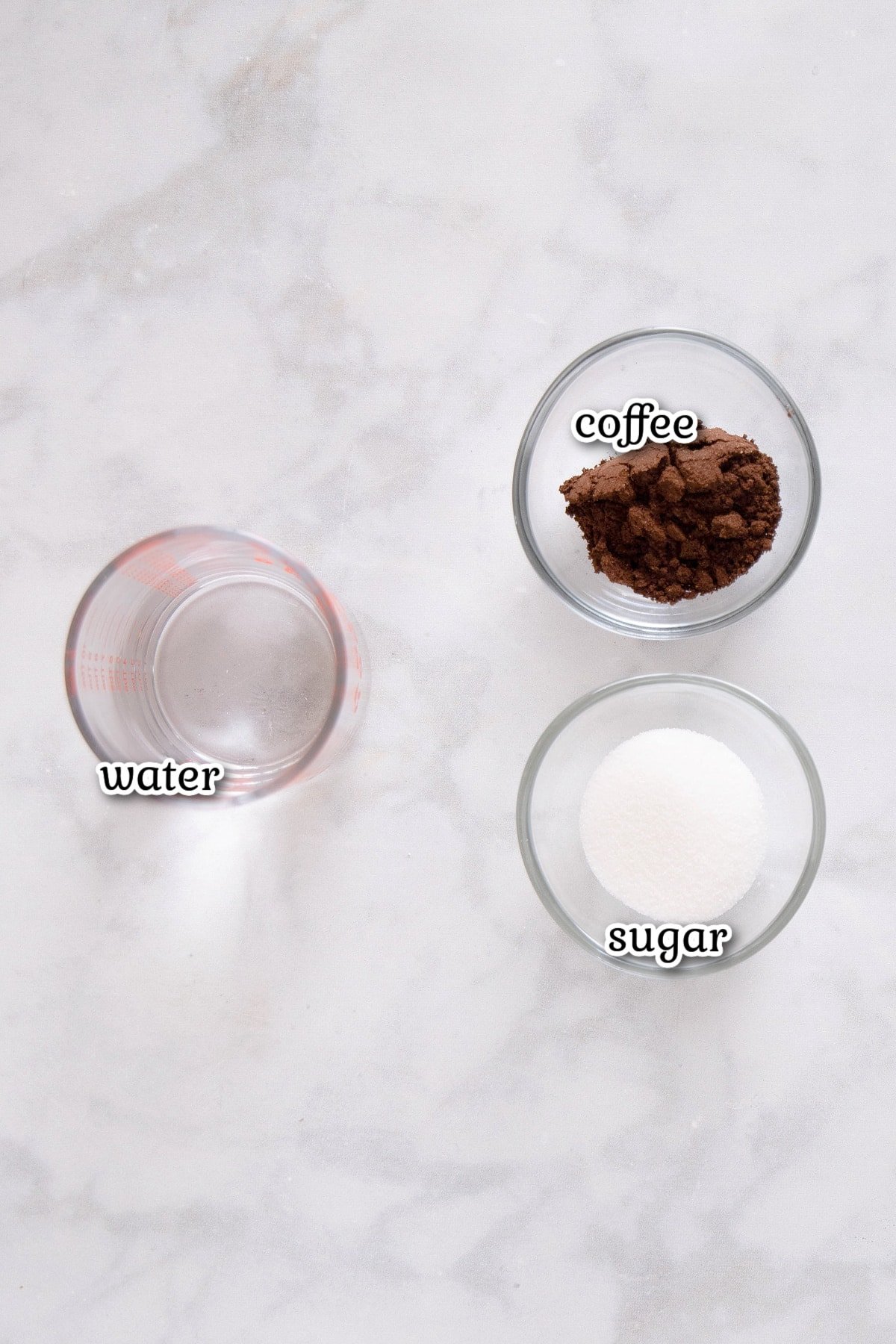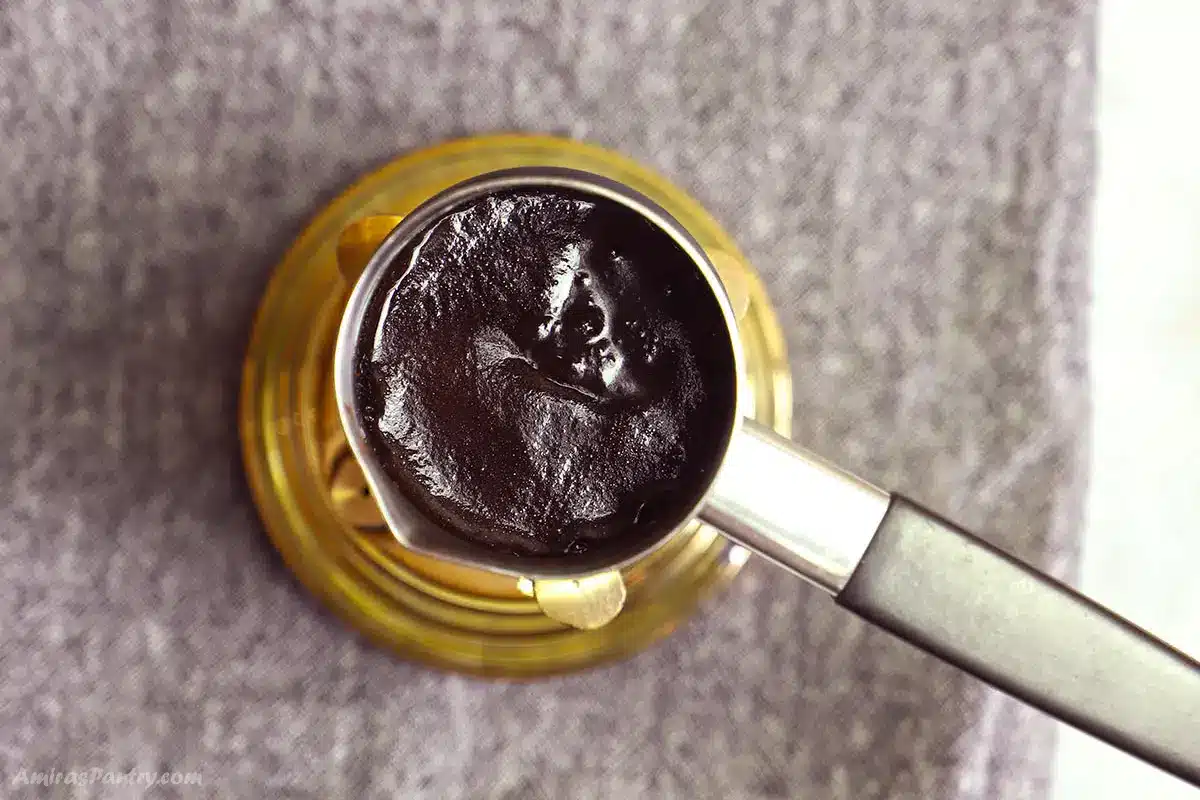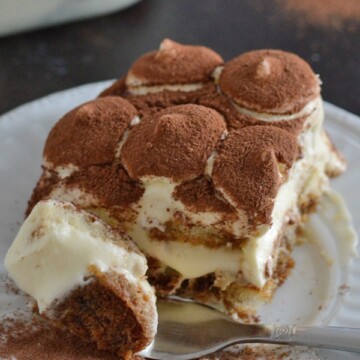Have you ever tried a rich, delicious cup of Qahwa? If not, you're missing out, it's a thick full-bodied beverage that's the perfect way to start the day. If you are wondering how to make Turkish coffee, so that you can try it at home, this is the post for you!
Jump to:
❤️ Why You'll Love It
- It's a rich full bodied coffee that will wake you up in the morning.
- It has a pleasant aroma and has the potential to add your own spices.
- Enjoy it with friends and family or just by yourself.
This rich coffee has a delicious taste and aroma that you will never forget. So, if you are a coffee lover then be sure to give this recipe a try.
📝 Ingredients
Note: This is an overview of the ingredients. You'll find the full measurements and instructions in the recipe card (printable) at the bottom of the page.

📋 Ingredient Notes
- Turkish coffee - This is a stronger brewed coffee, usually dark-roasted. You can find it in specialty grocery stores, or larger chain grocery stores.
- Sugar - You can add as little or as much sugar as you like to your coffee. I like to use granulated sugar, but sugar cubes would work okay also.
🥄 Instructions
Note: This is an overview of the instructions. The detailed instructions are in the recipe card below.
- Pour water into a coffee pot, add coffee and sugar stir for 3-4 times.
- Place the pot over medium-low heat and do not stir anymore.
- The coffee will start to bubble at the edges and rise up. Lower the heat to minimum and keep a watchful eye for like 30 seconds, do not let it boil. If it started to boil remove from heat for a couple of seconds then return it back.
- Slowly pour the coffee into the cup just until all the foam is in the cup.
- Return the pot to the low heat and let it foam up again.
- Remove from heat and slowly pour the remaining coffee into the cup.
👍 Tips
The secret to Turkish coffee is patience and practice. So, don't rush your coffee allow it to develop the thick foam on the top.
- You want the coffee to have a thick form on the top, which is called wesh in Arabic.
- If this is your first time making this, I recommend making one cup at a time.
- If you are making multiple cups, make sure that you divide the foam between the cups.
- I like to use espresso cups, as this is usually served in small cups.
- In the US there are two types of Turkish grounds. Plain and Gourmet which has cardamom.
- In the Middle East there are plenty of types of gourmet coffee and each shop has its own secret blend of spices for a flavorful aromatic out of this world coffee.
🍽️ Serve With
This coffee is usually served with a glass of water and Turkish Delight. You could also serve it with these Rhubarb Scones, chocolate covered dates or any candies you like.
☕ Arabic Coffee VS Turkish Coffee
- Arabic coffee is also commonly known as Saudi Arabia coffee.
- Arabic coffee is usually flavored with cardamom and saffron which are not a must in Turkish coffee.
- Arabic coffee is almost clear yellowish color while the Turkish one is brown.
- Brewing Arabic coffee usually takes some time and made in big pitcher called Dallah, while Turkish one is made in small percolator called cezve and it takes way less time.
✅ Turkish Coffee Etiquette
Do you know the reason that this coffee is traditional served with water? It's believed that if you serve your guests with water, and they drink the water first then they are hungry and you need to prepare a large feast.
If the guest goes for the coffee first, then you know that they might not be very hungry and you can make a smaller feast for them.
👩🍳 Variations
- You can add milk and sugar to the coffee and bring it to a boil. Pour it directly into a regular-sized coffee mug. This will not have as much foam.
- If you want to add a little spice to your coffee, you can add in a dash of ground cinnamon while it is brewing.
- If you don't like sugar in your coffee, you can leave it out, or use your favorite sweetener instead.
- Buy plain coffee like Mehmet Efendi and add your special spice blend to it. How about pumpkin spice for fall?
💬 FAQs
Turkish coffee is a strong, full-bodied coffee made by boiling finely ground coffee in water without filtering it. It has an intense flavor and its unique brewing process creates a thick foam on top that gives it its signature taste. It has a bitter taste than regular coffee that's why beginners usually add a lot of sugar to it. You should drink only the liquid and do not get to the muddy like paste at the bottom, this is the ground coffee itself.
For extra sweet use 3 teaspoons sugar for 1 teaspoon coffee. Or for medium use 2 teaspoons of sugar. For lightly sweet use ½ teaspoon of sugar. For more on that check the recipe card notes below.
Yes, Turkish coffee is generally stronger than regular coffee because it is not filtered and all the oils and grounds remain in the cup. It also requires a longer brewing time, which means more caffeine is extracted from the beans.
📣 Related Recipes
- If you looking for another delicious coffee recipe, then next time give this Ginger Latte a try.
- Tea with Milk has been known in the Middle East for such a long time now. Steep your favorite black tea with a splash of milk and sweetener for an exquisite quick and easy beverage experience.
- Bring delicious fall flavors into your home with this easy Homemade Pumpkin Spice Latte Recipe. Loaded with pumpkin, sweetened to your preference this pumpkin latte come fully flavored yet unloaded from unnecessary calories.
Coffee recipes
More Turkish Recipes
- Tulumba is a popular street food throughout the Middle east. Tulumba pastries are fried to golden brown and dunked in cold syrup for an out-of-this-world crunchy yet so fluffy on-inside sweet fritters.

Turkish coffee (Qahwa)
Ingredients
- 1 heaping teaspoon Turkish coffee 4 g
- 2 ½ fl. Oz. tap water
- 1 teaspoon sugar
Instructions
- Pour water into a coffee pot (cezve), add coffee and sugar stir for 3-4 times.
- Place the pot over medium-low heat and do not stir anymore.
- The coffee will start to bubble at the edges and rise up.
- Lower the heat to minimum and keep a watchful eye for like 30 seconds, do not let it boil. If it started to boil remove from heat for a couple of seconds then return it back.
- Slowly pour the coffee into the cup just until all the foam is in the cup.
- Return the pot to the low heat and let it foam up again.
- Remove from heat and slowly pour the remaining coffee into the cup.
- Serve immediately.
Notes
- The idea is to have a foamy thick layer on top of the coffee cup, in Arabic this is called wesh (literally translated as face), it is considered a disgrace to present coffee to guests without that foam.
- Making Turkish coffee needs patience and practice.
- When making multiple cups divide the foam between cups.
- If you are a beginner I do not recommend making more than one cup at a time.
- Turkish coffee are usually presented in small cups, if you do not have these cups, espresso cups can work too.
- Turkish grind coffee comes in two flavors here in the US, plain and gourmet with cardamom. In the Middle East there are plenty of types of gourmet coffee and each shop has its own secret blend of spices for a flavorful aromatic out of this world coffee.
- Variations:
- Make it with milk, this is usually served in a regular coffee mug (8 oz). Place milk along with coffee grind, sugar and sometimes a dash of cinnamon. Bring to a boil on medium low and pour directly into the mug there is no need for the foam style presentation here.
- There are other levels of sweetening the Turkish coffee:
- Super sweetened this is a beginners level (Sarya’osee in Arabic): 3 teaspoons sugar for 1 teaspoon coffee.
- Extra sweetened (Zeyada in Arabic): 2 teaspoons sugar to 1 teaspoon of coffee.
- Medium sweetened ( Manoo in Arabic) : 1 ½ teaspoon sugar to 1 teaspoon coffee.
- Just right swatted ( Mazboot in Arabic) : 1 teaspoon sugar to 1 teaspoon coffee.
- Non sweetened ( Al Reha) for experienced coffee drinkers: 0.5 teaspoon sugar to 1 teaspoon coffee.
- Non tweeted ( Sada): zero sugar and only coffee
- How to drink and serve Turkish coffee (Turkish coffee etiquette):
- Turkish coffee must be served on a tray with a tall glass of cold water. It is said that in the Arab world they usually serve water with coffee to know if their guest is hungry or not. If the guest picked up the water first then they know that the guest is hungry and they must prepare a banquet immediately. If he pick up the coffee first then he is not that hungry and they should prepare light banquet instead.
- In Egypt, it is from the traditions to only serve non sweetened Turkish coffee during solace when you go to give comfort to the family of a deceased person. This tradition is still practiced in many parts of Egypt.
- When drinking Turkish coffee you should sip it lightly without making a sound and do not stir the coffee and disturb the coffee grounds as they will accumulate at the bottom of the cup.
- It is also from the old traditions in many countries to flip the cup after finishing drinking the coffee of course on the small plate. Then old ladies and grannies take a deep look into the cup to read the future of the person. Worth noting that this practice is no longer practiced among Muslims as it goes against Islamic believes.
- Please check the nutrition disclaimer policy.














Karen
Great notes on how to make this… can’t wait to try it!!